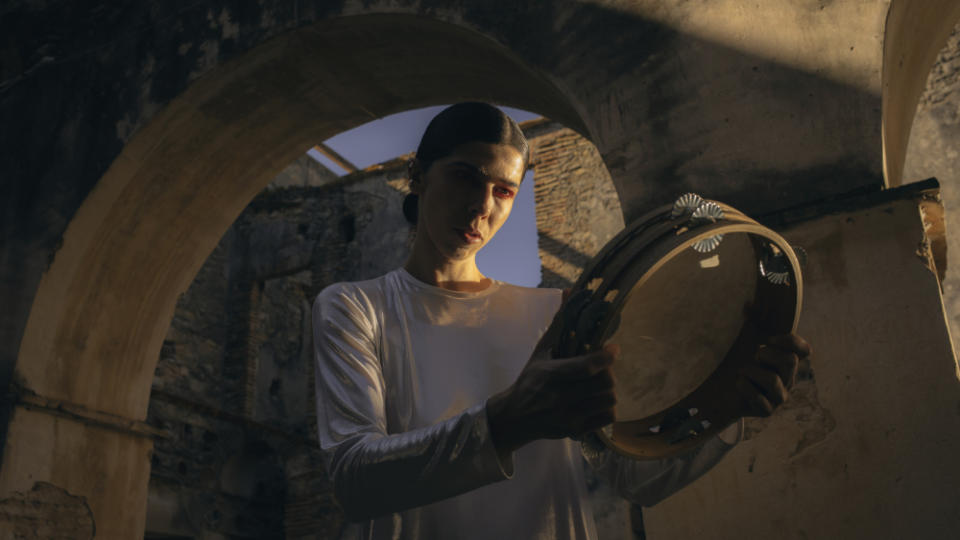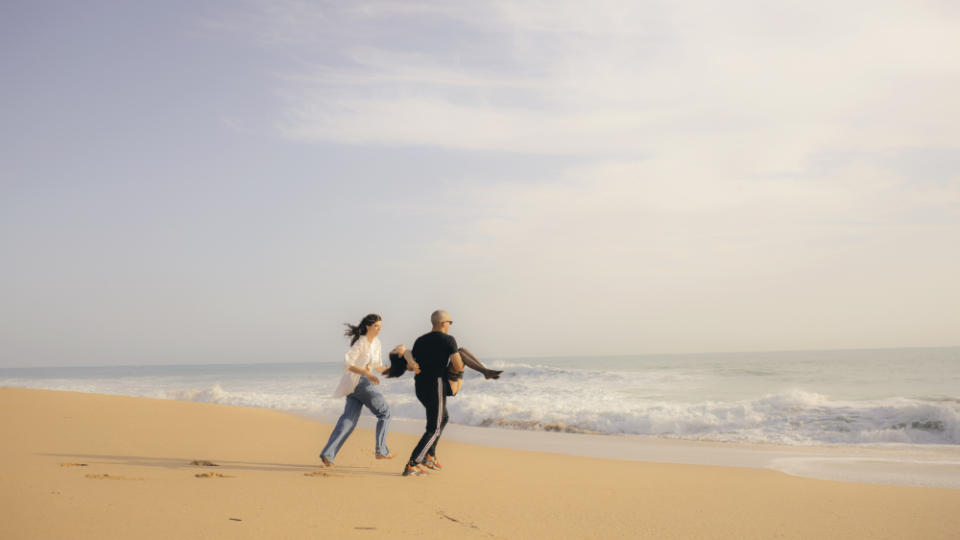‘Elite’ Star Omar Ayuso’s Locarno Title ‘On the Go’ Swooped on by MPM Premium (EXCLUSIVE)
- Oops!Something went wrong.Please try again later.

In the run-up to Locarno, Paris-based MPM Premium has swooped on world sales rights to “On the Go,” a showcase of the acting talents of Omar Ayuso, Omar in Netflix mega-hit “Elite,” playing in “On the Go” a Grindr addict with vengeance in his heart.
Set to world premiere in Locarno’s Cineasti del Presente, “On the Go” also has a first trailer, shared in exclusivity with Variety.
More from Variety
The trailer captures much of the spirit of the freewheeling road movie through an Andalusia of music, dance, sex and sensuality –though none of the film’s nudity – of a feature, written-directed by Maria Gisèle Royo and Julia de Castro, which revisits from a female perspective an extraordinary Andalusian feature, 1982’s “Corridas de Alegría.”
From the mid-70s, when Spain secured a democratic government after 40 years of rule by the arcane ultra-conservative Francisco Franco, Spain came out of the convent, unleashing an extraordinary wave of pent-up creativity and sex, captured in music and movies in what came to be called La Movida.

If Spain’s Movida was inspired by Britain’s punk, it replaced British aggro with drugs and sex. Early Pedro Almodóvar captures that libertine spirit. So did brothers Gonzalo and Javier García-Pelayo, launching Gong, one of the two biggest indie music labels in Spain, famously fusing flamenco and rock with Triana, and in cinema making four Andalusia-set movies climaxing in “Corridas de Alegría.” The film melded the social conscience and issues of art cinema with a sexual frankness near shocking in such cinema, the unpredictability of a road movie and some great flamenco tracks paying homage to composers such as Manuel Sánchez Pernía and Benito Moreno.
“On the Go” quotes consistently from “Corridas”: Both films begin with a protagonist, Jonathan (Ayuso) in “On the Go,” dousing a nightclub with petrol and setting it on fire; both road movies’ cars have faulty petrol gauges, and are stolen; and so on.
The crucial echo, however, is in focus. “Corridas de Alegrías” was informed by themes, friendship and the failure of love, said García-Pelayo.
“We review these two themes 40 years later, immersed in the era of dating apps, eternal youth, and economic insecurity. The context is conformed by a vital period both of us shared: the last years of fertility in a historic moment for the self-sufficient woman,” said Royo and Castro.
Both films also share an irrepressible sense of humor, seen in the trailer. It begins with Milagros (De Castro), set on motherhood but unemployed and reluctant to use an anonymous sperm donor, arriving in Seville in her father’s ’67 Corvair to persuade her gay friend Jonathan to be her sperm donor.

“I want my son to inherit from his father his generosity, honesty, intelligence and joy,” she says in an intimate voice over. As she speaks, scenes play supposedly illustrating such qualities in Jonathan, who insults a man, “Why don’t you eat my ass, faggot?” (that’s an example of honesty), offering a cigarette (generosity) and declaring the ’67 Corvair has run out of petrol (intelligence).
The depth of Jonathan’s joy is also questionable, not for the scenes shown – dancing flamenco, robbing a car at pistol point as he motor-mouths homophobic put-downs at its former occupants – but because of the film’s plot, captured helter skelter in the trailer, galvanized by a terrific 2021 Andalusian rock song “Gitana,” from Derbys Motoreta’s Burrito Kachimba, hailed as inheriting the mix of flamenco and rock of legendary ’70s group Triana.
Having torched the club in Seville, Jonathan insists to Milagros they have to get out of town fast. Stumbling on a young woman (Chacha Huang), called Triana’s Queen, who claims she’s a mermaid and has to get to the sea, Milagros and Jonathan, drive to a beach beyond Jerez de la Frontera, far enough from Seville.
Someone, however, an aged man, Tonic, the club owner, is on their trail. Jonathan has quick sex with a Grindr contact in a bathroom; Milagros’ attempt to get pregnant from a stranger she likes comes to nothing, making her all the more certain that Jonathan should be the father. But Jonathan has his own traumas of sexual abuse which need closure.
“On the Go” is a road movie where a spectator isn’t quite certain what’s going to happen next, whether it’s shots of a Zebra fish’s severed heart, or a scene capturing the now advanced in years Gonzalo and Javier García-Pelayo sitting at a table reminiscing about casinos and oral sex with tea.
“Our cinema plays with the limits of narrative conventions by walking on a narrative logic between the surreal and the delirious, where anything can happen at any time without the need to foresee it in the plot. Freeing itself from conventions at every turn,” said Royo and De Castro.
“With its blend of flamenco music and outrageous humour, ‘On the Go’ is a wild ride echoing the first films from early Almodóvar and Greg Araki,” said Quentin Worthington, MPM Premium head of sales & acquisitions.
He added: “‘We love ‘On the Go’ for the modernity of its two characters, with carefree feminist Milagros (Julia de Castro) on a journey to create her own definition of motherhood, while Grindr-addict Jonathan (Omar Ayuso) comes to terms with insatiable sexual desires. Their project to form a family – dysfunctional in appearance – never felt so touching and contemporary. We are proud to acquire and represent under our New Visions label this bold comedy from Spain in which shine the stars of tomorrow.”
“On the Go” marks the first fiction feature of both Royo, a Student Oscar winner (“Rediscovering Pape”) and also art director on “H,” a Film Independent Spirit Awards winner, and De Castro, singer-actress founder of De la Puríssima, which toured the world for a decade, and star of celebrated 2015 short “Anatomia de una criminal.” She also has a main role in new Movistar Plus+ comedy, “De poquita fe.”

Variety chatted briefly with De Castro and Royo in the run-up to Locarno:
What impact has “Corridas de Alegría” on your direction of “On the Go”?
María Gisèle Royo: There are formal decisions. Firstly, the aspect ratio, we shot in 16 mm respecting the academic 1.37:1 format. Shooting on film was a difficult decision because it implied restrictions that we assumed were necessary. The form is the result of a methodology and limitations that affect the process. The lack of resources forced us to work with limited footage. This led to extreme shooting that in most cases included only one attempt. That is, it was rehearsed on set until the technical and artistic team had a clear understanding of the scene and it was shot in a single take, in most cases.
Which would open the door to more spontaneity, a sense of capturing the moment….
Royo: Yes, the result becomes a document of the process, so we look at the collected material almost as an archive, a unique document of the shooting in which the improvisations, both acting and cinematographic, responded to irreversibly captured spontaneous reactions. Shooting in 16mm on an aesthetic level makes the image organic and the process much more traditional. We have included exposure errors, burns and scratches in the editing, something essential in experimental cinema, which we also refer to, such as the use of perforations in the negative, a reference to “El Futuro,” directed by Luis Lopez Carrasco and edited by Sergio Jiménez, an editing advisor on “On the Go.”
Music was essential to “Corridas de Alegría” and is for “On the Go.” What was the overriding intention of the use of music?
Julia de Castro: We wanted to have a soundtrack mixing the time we were inspired by, the ’70s and 80s, groups like Burning, as well as Ricardo Yunque, taking into account the lyrics and the atmosphere they create. Mixing this with contemporary Spanish bands, singers and dancers that also appear in the film: Miguelito (from Derbys Motoretas Burrito Cachimba), Alvaro Romero, Da Mopa and Paco Soto, the flamenco guitarist player. For the English-speaking character, we introduced a foreign song, “Fire” from Nina Kraviz.
Could you break down which group sings which song at some key moments?
De Castro: When Jonathan burns down the club, the rock song playing is from Burning’s “Like a Shot (como un estallido)” which the García-Pelayos’ label Gong released in 1975. The song that begins “It’s this thirst for life…” is from Alvaro Romero, who plays Jonathan’s Grindr partner in the film. He sings it in the bathroom scene. It’s based on a poem by Sevillian poet Braulio Ortíz. A slow car chase features part of “Gitana.” The head of Derbys, Dandy Piranha, plays the stolen car’s driver. The song he sings has lyrics from nineteenth century Sufi poet Omar Khayyam. The dancer at the baptism is Leo Leal, a very important contemporary flamenco dancer. “Porque la vida es así,” sung by Ricardo Yunque and released in 1980, ends both “Corridas de Alegría” and “On the Go.”
The film’s scenes vary hugely in tone and also aesthetics…..
Royo: The cinematographic approach does not seek uniformity, each scene has its own approach. We looked for a fresh and committed visual language that defines us. We mix the possibilities of analog and digital, seeking to surprise in each scene, and we drink from very eclectic references that converge in the essence we are looking for: a film full of energy, vitality, sensuality and strength.
Best of Variety
Sign up for Variety’s Newsletter. For the latest news, follow us on Facebook, Twitter, and Instagram.

